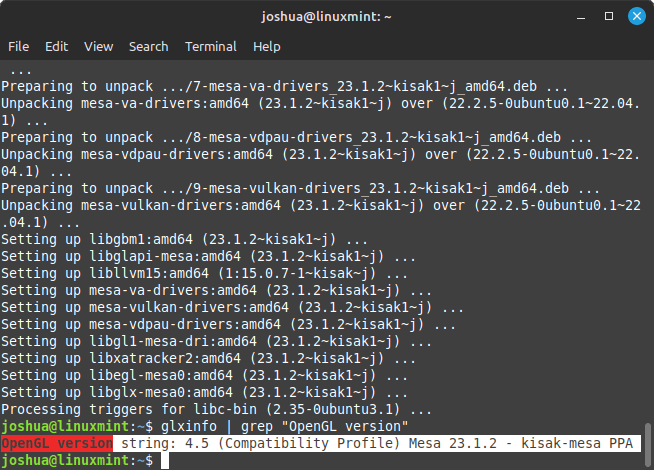Mesa drivers are essential for providing OpenGL, Vulkan, and other graphics API support on Linux systems. They enable better performance and compatibility for gaming, multimedia, and graphical applications. Upgrading to the latest Mesa drivers can significantly improve graphics performance and support for new hardware features. The Kisak PPA is a reliable source for the latest stable versions of Mesa drivers, ensuring you have access to the most recent advancements in graphics technology.
Upgrading Mesa drivers on Linux Mint 22, 21, or 20 using the Kisak PPA can enhance your system’s graphics capabilities but may occasionally introduce compatibility issues or bugs. This guide will walk you through upgrading your Mesa drivers and showing you how to restore the default drivers if needed.
Update Linux Mint Before Mesa Drivers Upgrade
Starting with an updated system is essential to avoid compatibility issues during the Mesa drivers upgrade. To update your Linux Mint, execute the following command in the terminal:
sudo apt update && sudo apt upgradeThis command performs two functions:
sudo apt update– Updates the package index, ensuring you have the latest listings of available packages.sudo apt upgrade– Upgrades all installed packages to their latest versions, maintaining system stability and security.
Install Initial Packages for Mesa Drivers Upgrade
Specific utility packages facilitate the Mesa drivers upgrade. These include:
mesa-utils: This package provides tools such as glxinfo, which displays information about your system’s current OpenGL implementation. This information is vital for understanding your graphics setup.ppa-purge: This utility safely removes PPAs (Personal Package Archives) and reverts to the official distribution packages, which is particularly useful if you need to roll back Mesa driver changes.
Install these packages with the command:
sudo apt install mesa-utils ppa-purgeNote: While the ppa-purge package is effective, it may not remove all aspects of the Mesa drivers altogether. It’s an initial step for potential driver removal.
Determine the Current Mesa Drivers Version
Understanding the current version of your Mesa drivers is crucial. It helps you decide whether an upgrade is necessary and verify its success.
To check your current Mesa driver version, use:
glxinfo | grep "OpenGL version"This command filters and displays your current OpenGL version. The output will be specific to your system’s Mesa driver version, providing a clear baseline for the upgrade.

Remember, your output will vary based on the specifics of your installed Mesa drivers. This information is key in informing you about your system’s current state before upgrading.
Import Kisak PPA for the Latest Mesa Drivers
The Kisak PPA repository is pivotal for accessing the latest Mesa drivers. It offers advanced driver updates, enhancing your system’s performance and capabilities. To integrate the Kisak PPA into your Linux Mint, use the following command:
sudo add-apt-repository ppa:kisak/kisak-mesa -yThis inclusion ensures that the Kisak PPA expands your system’s software sources list, offering access to a broader spectrum of Mesa driver updates.
Upgrade Linux Mint System Packages, Including Mesa Drivers
Once the Kisak PPA is added, the next step is to refresh your system’s package list. This update acknowledges the newly available Mesa driver versions in the Kisak PPA.
Execute this command to refresh the package list:
sudo apt updateObserving updates related to Mesa drivers during this process indicates readiness for the actual driver upgrade. To upgrade Mesa drivers alongside other system packages, use:
sudo apt upgradeThis command will elevate all packages, including Mesa drivers, to the newest versions in your current software sources, including the Kisak PPA.
Post-upgrade, verifying the successful installation of the new driver version is essential:
glxinfo | grep "OpenGL version"Executing this command should display the updated Mesa driver version, affirming the success of your upgrade process.
Reverting to the Default Mesa Drivers
Install the PPA-Purge Utility
When the Mesa driver upgrade leads to issues, the ppa-purge utility becomes essential. It effectively reverts your system to its original state before the PPA installation. The utility removes the PPA from your software sources and downgrades any installed packages to the official Linux Mint repository versions.
To install ppa-purge, run this command:
sudo apt install ppa-purgeDowngrading Mesa Drivers
Once you have ppa-purge installed, the next step is to downgrade the Mesa drivers. The specific command depends on your version of Linux Mint.
For Linux Mint 22 users:
sudo ppa-purge -d noble ppa:kisak/kisak-mesa -yFor Linux Mint 21 users:
sudo ppa-purge -d jammy ppa:kisak/kisak-mesa -yFor those on Linux Mint 20:
sudo ppa-purge -d focal ppa:kisak/kisak-mesa -yThese commands are generally reliable, but systems with multiple PPAs or extensive customizations might encounter complications. Always back up your system data before executing such significant changes.
Confirming the Downgrade
After executing the downgrading process, validating that the Mesa drivers successfully reverted to their default version is crucial. This step repeats a familiar process; we will use the glxinfo utility to check the current version of the Mesa drivers.
glxinfo | grep "OpenGL version"This command should display the Mesa driver version that your system initially had. Successfully reverting to this version confirms the effectiveness of the downgrade process. This method ensures you can manage and revert your Mesa drivers as required, providing a safety net for your Linux Mint system.
Concluding Remarks
By upgrading your Mesa drivers on Linux Mint using the Kisak PPA, you can benefit from the latest graphics performance improvements and hardware support. Be mindful of potential compatibility issues and have a plan to restore the default drivers if necessary. Regular updates and maintenance will help keep your system running smoothly, allowing you to enjoy the enhanced graphics capabilities of the latest Mesa drivers.


